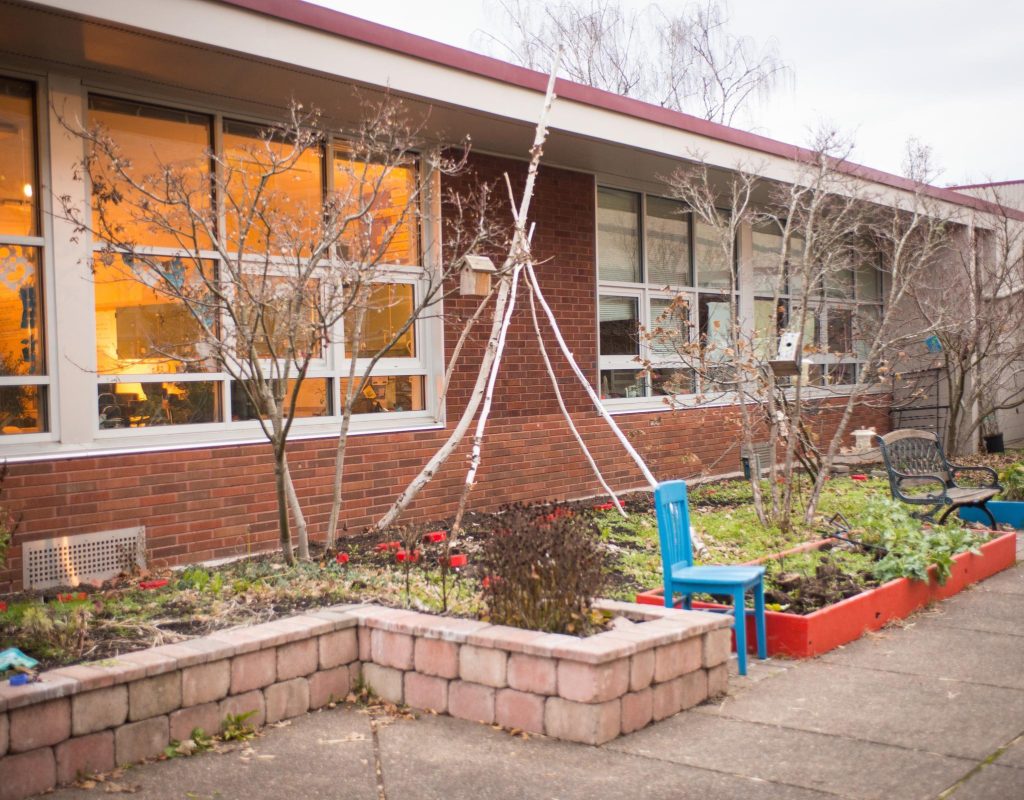
Senior Communications Manager
In 2018, Oregon schools served 249,411 students with grant-funded farm to school programming—including school gardens, procurement of local goods through a distributor or direct from producers, and in-classroom or on-farm education. In total, 131 districts participated in some kind of local purchasing. Supported by the forward-thinking legislation that recently allocated $15 million to state programming, in many ways, farm to school in Oregon has been at the leading edge of a nationwide movement. However, in the current reality and with schools closed, many students and their families are facing dire food insecurity.
With new logistical requirements and limited staffing, schools are working hard to pivot while still providing meals. Angela Hedstrom, our farm to school coordinator, is the Portland Metro lead for the Oregon Farm to School and School Garden Network’s (OFSSGN) Procurement Hub—a network of school food service directors and staff, producers, distributors, community partners, and educators who come together to approach shared challenges and opportunities in purchasing, serving, and celebrating local food. In the interview below, she talks about what’s happening now, where she’s seeing resilience, and current challenges around keeping farm to school relationships afloat.
One of the ways partners throughout the state are trying to support schools is by providing responsive technical assistance and information around the changing requirements and standards for meals and meal service. Right now, I’m trying to learn all I can about current school meal operations and about some of those really technical details so I have a baseline understanding of what food service folks are dealing with.
Typically, my work is focused on helping schools procure local food, so I’m also trying to figure out what the shifts in school meal programs mean for local producers.
The way I understand it, state agencies are in charge of how meal programs are implemented. But depending on what they qualify for and what their needs are, each district operates differently. The variation in meals currently being served is based on a handful of factors, including U.S. Department of Agriculture (USDA) free and reduced lunch reimbursements, partnerships individual schools or districts may already have established, and school district infrastructure to prepare, transport, and serve meals.
The Oregon Department of Education (ODE) is the overarching body that districts work with to adhere to federal child nutrition standards, overseen by the USDA. The standards are complicated but important to understand, because schools that offer free and reduced priced meals receive federal reimbursements to offset some of those costs.
Recently, ODE requested certain waivers from USDA so that they can operate their meal programs differently. For example, in the standard summer meal program model, a child between the ages of 1 and 18 must be present in order to receive a meal. Now, that requirement has been waived, and a family member can pick up the meal without the child/children present. In addition, up to one week’s worth of meals can be provided at a time. We’ve seen examples come in from schools, primarily in rural locations, using buses to aggregate and distribute food to different community locations. In that case, too, a parent or guardian can pick up food without needing to have their child present.
The piece that is confusing right now, is how schools are covering the cost of meals during closures. Our current situation is a combination of school-year meals and summer meals: Typically, meals during the school year are paid for with a combination of federal reimbursement for students who qualify for free or reduced lunch and full-price meals that families pay for. In the summer meal program model, as I understand it, meals are free to anyone between the ages of 1 and 18 who shows up. Summer meals are reimbursed at a higher rate, since kids who participate don’t pay.
For some programs, the cost of providing meals in this strange time is higher—they may have needed to buy supplies that weren’t in the budget, they may be paying staff who are not currently able to work, and no child is paying for meals. School nutrition services plan their budgets and meals pretty far in advance. I’m concerned that what’s happening now may skew the numbers for budgets and federal reimbursement qualifications for next school year. Districts that don’t have high free and reduced lunch rates might not have a need—or funding to support—a meal program right now, but I don’t know for sure, and I’m trying to figure it out.

A school courtyard. Shawn Linehan
What about farm to school specifically? Your work is to primarily support relationships between schools and producers. Are they able to maintain those right now, and are schools still buying locally for their current meal efforts?
School food service staff are knee-deep in direct response. While our partners at ODE are still getting receipts from schools purchasing Oregon products with the farm to school grant funds, those have slowed down.
Recently, I worked with the Oregon Department of Agriculture (ODA), ODE, and OFSSGN to create a survey for school food service directors to see what their meal programs are like right now and how we can work in solidarity with their efforts.
What we’re trying to figure out is how likely it is that they will buy local foods right now and get a baseline about where we should put our energy. We want to figure out if we can help them source locally during this unprecedented time or if it is completely out of the scope of what they’re able to do.
Early results from our survey show that a lot of schools, even those with long-time local purchasing programs, are challenged to use local items in their current meal programs, based on social distancing requirements. Some of them say it’s likely that they would buy local. But many are saying they aren’t able to utilize local products, either from their distributors or direct from producers. Everything needs to be pre-portioned, peeled, chopped, ready-to-go, and we don’t really have the infrastructure for local products to be able to meet that need right now. There are some distributors who offer chopped and prepackaged fruits and vegetables. Some of these may be Oregon-grown, but most aren’t right now based on seasonality.
While the nuance of individual programs is really varied, I’m trying to get a handle on that—particularly for the Portland Metro Area, because I’m the regional hub lead for this region. But as I said, based on the survey we sent to schools, the responses were nearly unanimous in their need for prepackaged, pre-portioned items. Right now, to bring in more local products, what it will really take is for either schools or producers to have access to infrastructure for processing.
If we can figure out how to address infrastructure needs in the next couple months as the big production season ramps up, we could address a long-term need. That would be a win-win, even once school nutrition staff go back to business as usual.
There are definitely examples where resilience and connection are shining through:
I’m still hearing from value-added businesses who are selling to schools, like Lucy De León who recently delivered her tamales to schools in Hillsboro.
The school garden network in the state is strong, and those folks are connecting with each other regularly. Garden educators are coming together to talk about how their work is being impacted and how they can keep connecting with kids and families. Some are continuing to tend school gardens—both to provide food for neighborhood families and so that when students do return to school, their garden classroom is ready for them. Others are putting together take-home garden kits to distribute at school meal sites.

“
—Angela Hedstrom
And it’s important to note that the $15 million in farm to school funding from the state is still in effect. We’ve known for a while that schools are looking for local, minimally processed items, and have struggled to move that priority forward. But now, for the first time through this most recent state funding allocation, producers can apply for funds to purchase processing equipment. Those grants just closed, and we should learn more about who is receiving those funds in the next couple months.
There is also inherent resilience in the relationships we have developed over many years, with state agencies like ODA, ODE, and OFSSGN. We are in close contact with each other and are leaning on long-time collaboration to do what we can to support schools, local producers, and families.
I think it’s too soon to say where we will see the strongest examples of resilience in farm to school. There is an interesting oscillation between how we can support farm to school programming now and what we can do to ensure its viability in the long term. As with other systems in our country, the coronavirus pandemic is shining a glaring light, with a magnifying lens attached to it, on the challenges and inequities in our food system, and on farm to school as part of that system, that we already knew existed. Now is the time to highlight the vitality of our local and regional food system and the strength of the relationships between people working together to transform the system for the better.

blog
In a collaboration with the Redd on Salmon Street and Ecotrust, Feed the Mass is preparing, delivering, and serving hundreds of free meals every week.

blog
We connect with the Redd campus manager, B-Line founder, and our VP of events and engagement for an update on activities at the Redd campus amid COVID shutdowns.

blog
Our team works with the Keex’ Kwaan Community Forest Partnership to keep safety top of mind in planning the summer season.